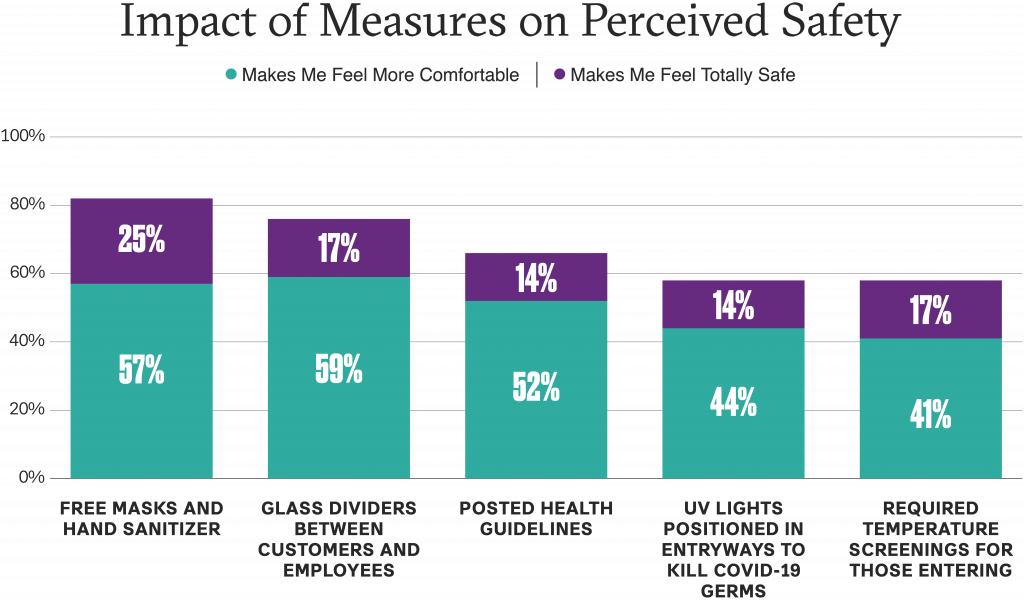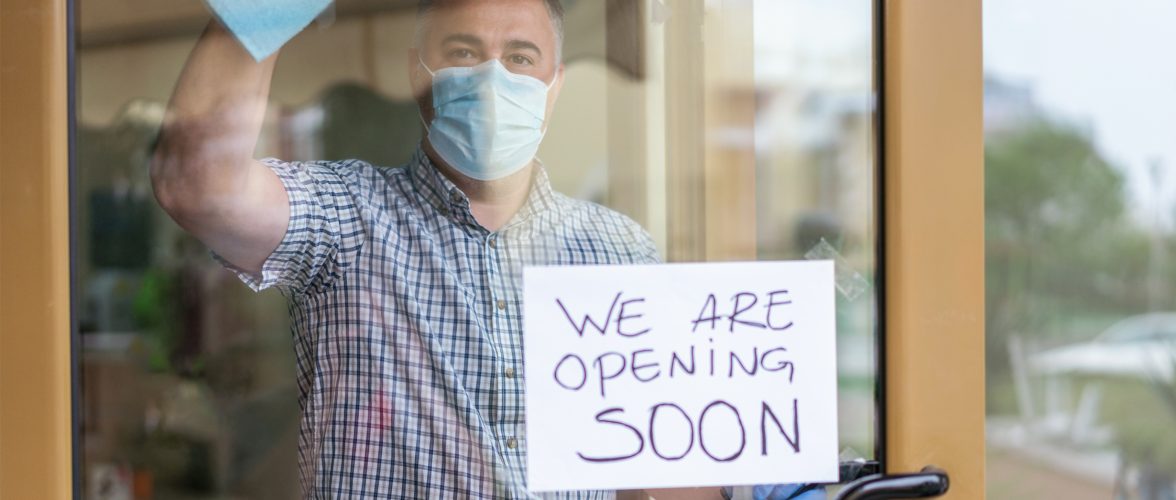As businesses start to reopen in nearly every state, leaders face difficult decisions around how to create an environment in which employees and customers are not only physically safe but also feel comfortable enough to return.
A challenge with this is that many of the most effective actions businesses can take to protect employees and customers aren’t easily visible, and therefore may not on their own translate to helping people feel more comfortable. Customers generally don’t see a plane or hotel room being cleaned, nor are they watching their food get prepared in a restauraunt. That’s why detailing and communicating all COVID-19 health processes – including those that may not be visible – is critical for any business welcoming back employees or customers.
And while media attention naturally gravitates toward the sci-fi-esque technology claiming to blast away COVID-19, our research shows that some of the simplest actions, such as offering free masks and hand sanitizer, have the biggest impact on perceived safety.

Q: Some businesses are investing in health and safety measures to keep their employees and customers safe when they reopen. Please rate each of the following precautions on how they would make you feel when entering a business with other people.
But what makes people feel safe does not always translate to what will ensure their physical safety.
That’s okay, as long as those actions are part of a broader plan that does protect physical health. Consider temperature checks. Many businesses are investing in technology solutions to enable contactless temperature checking and companies are rising to meet the new demand. One such company is IntraEdge, which just launched a self-check temperature kiosk in late May.
Purple’s Pulse Survey survey finds required temperature screenings would make 58% of people more comfortable or feel totally safe going to a business. But how would checking the temperature of everyone who enters a business stack up on actual safety?
March WHO data show 80% of COVID-19 cases are mild or asymptomatic. While the technology is able to identify those exhibiting fever symptoms, it is ineffective against the larger share of asymptomatic cases.
Dan Clarke, president of IntraEdge products and solutions, recognizes this fact, and describes its kiosk as just “one piece of the puzzle” for states’ reopening. While the puzzle piece of identifying and stopping those symptomatic cases from spreading is indeed an important one, businesses that fail to recognize and enforce the others needed to protect people’s health can do more harm than good. If people aren’t properly educated about the constellation of actions needed to protect their safety, it can feed a false sense of security that emboldens them to neglect vital complementary precautions.
While both physical safety and perceived safety are important for businesses, “safety theater” is what happens when they get the balance wrong.
What is ‘safety theater’?
Safety theater is when a company takes performative steps to provide the feeling of improved safety, but without doing enough to ensure it physically.
Some bad actors may intentionally lure customers and employees back to an unsafe environment; however, it’s far more likely that well intentioned companies and brands will inadvertently take the safety theater’s stage.
Intentions aside, participating in safety theater can have serious consequences. Above all else, it jeopardizes the health and safety of employees and customers. Doing so can also have material reputation ramifications, however, including undermining a company’s credibility, diminishing trust, and contributing to the perception that they are putting profits over people.
As companies’ response to COVID-19 continues under the microscope, missteps won’t just affect those interacting with the company directly. Stakeholders are ready to hold companies accountable for perceived missteps, and social and traditional media can easily amplify the voice of even a few critical onlookers.
Selling ‘safety theater’
After 9/11, an entire industry was built seemingly overnight to protect physical spaces from a safety and security threat. Similarly, in the face of COVID-19, countless companies have begun marketing their solutions to keep people safe and allow businesses to reopen.
Another technology gaining interest is UV light walkthroughs, which purport to kill germs on those who pass through them and would make most people (58%) more comfortable entering a business. While businesses may be well intentioned in investing in this technology, it falls short of stopping the spread of potentially dangerous germs once people have entered a controlled space. If reliance on this technology causes employees and customers to overlook other important protocols, the effects of the measure can actually be counterproductive.
How can leaders avoid the safety theater trap?
First and foremost, follow advice of health experts. Health experts and organizations are not only the most qualified to provide proper guidance, but stakeholders also view them as the most credible. Following their lead on protocols that have been proven most effective – and adapting your policies to new information – may turn off a small group of vocal customers in the short term, but will protect your long-term business and reputation.
Implement COVID-19 health guidelines, and communicate regularly and transparently. Making changes to your business like providing health shields for customers and sharing detailed and clear health guidelines can go a long way to make people feel safe and prevent further spread of the disease. In doing so, recognize that no single measure will offer complete protection, and always communicate where there may be deficiencies.
Don’t ignore onlookers. What’s theater without an audience? Remember your actions have visibility beyond those with whom you’re engaging directly. Proactively communicate through channels that inform in-person audiences as well as those watching the show remote.
Purple Pulse Survey of the US Informed Public. N=834. June 10-13, 2020.
By Diana Muggeridge | diana.muggeridge@purplestrategies.com
Purple is actively partnering with companies and industries to navigate the ever-changing COVID-19 pandemic and prepare for the future that will come after, bringing deep experience helping the world’s best-known companies navigate the world’s toughest challenges. Please reach out to author Diana Muggeridge or any member of our Purple team to let us know how we can support you.

 Reclaiming Trust When Under Fire
Reclaiming Trust When Under Fire  Reclaiming Trust When Your Products – and Intentions &...
Reclaiming Trust When Your Products – and Intentions &...  Brad Dayspring Joins Purple Strategies as Executive Director
Brad Dayspring Joins Purple Strategies as Executive Director  Celebrating Growth and Leadership at Purple
Celebrating Growth and Leadership at Purple